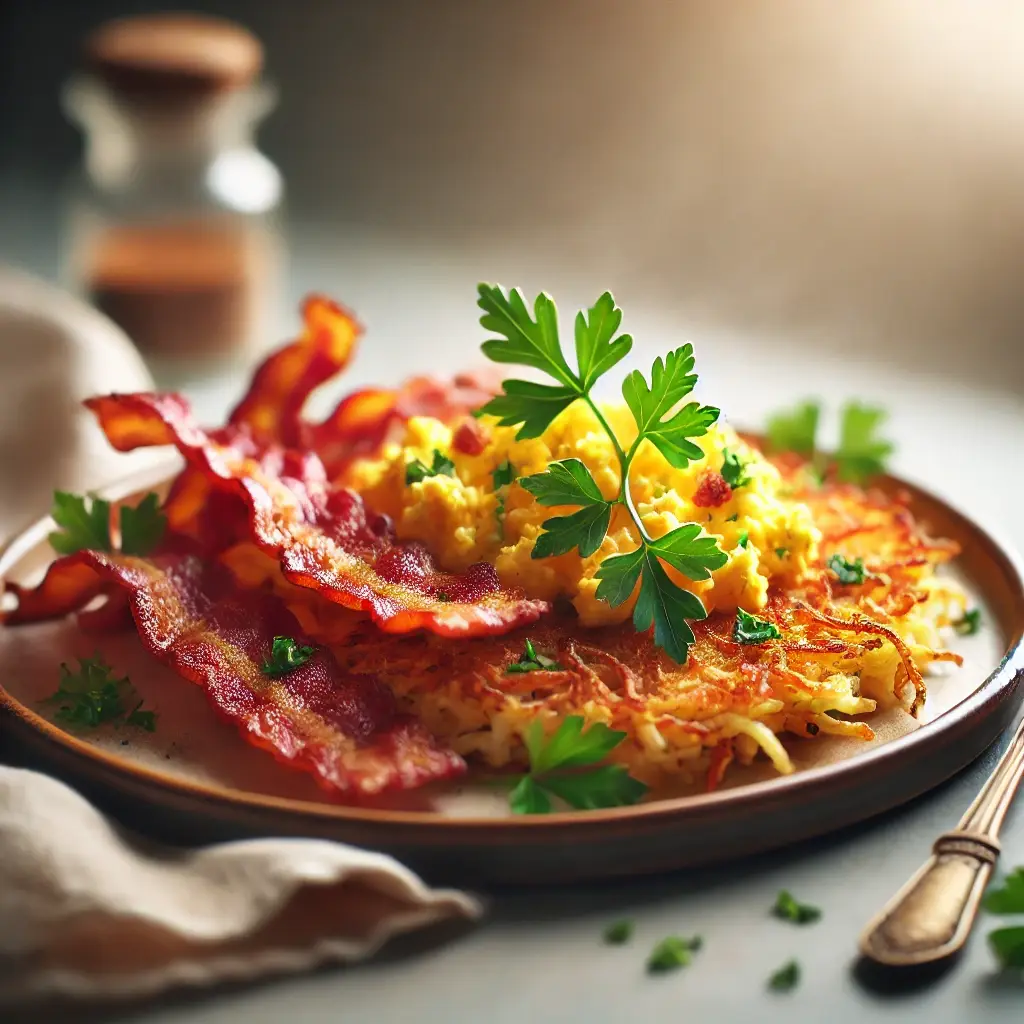There’s something magical about biting into a crispy, golden-brown hash brown that’s perfectly cooked on the outside and tender on the inside. Whether you’re a breakfast enthusiast or just someone who loves the versatility of potatoes, mastering homemade hash browns can transform your morning routine. This guide will walk you through everything from choosing the right potatoes to cooking techniques that guarantee restaurant-quality results. Let’s dive in!
Part 1: Understanding Hash Browns
What Are Hash Browns?
Hash browns are a classic breakfast staple made from grated or finely chopped potatoes. These potatoes are shaped into patties or left loose, then fried until crispy. Loved for their simplicity and crunch, hash browns pair well with eggs, toast, and a variety of other breakfast dishes. They’re a perfect example of how basic ingredients can create culinary magic.
History and Popularity of Hash Browns
The roots of hash browns trace back to the late 19th century in America, where they first appeared as a diner favorite. Over the years, their appeal spread worldwide, becoming synonymous with hearty breakfasts. The crispiness of hash browns has made them a beloved comfort food, adored by both home cooks and chefs.
Stay tuned as we delve deeper into the specifics, including how to select the right potatoes and master the techniques that make your hash browns irresistibly crispy!
Part 2: Selecting the Right Potatoes for Crispy Hash Browns
Starchy vs. Waxy Potatoes: Which Is Best?
Choosing the right potato is the first step to mastering how to cook crispy hash browns at home. Potatoes come in two main varieties: starchy and waxy. Starchy potatoes, like Russets, are high in starch and low in moisture, making them ideal for crispiness. On the other hand, waxy potatoes, such as red or Yukon Gold, are better for dishes where a firmer texture is preferred.
For hash browns, starchy potatoes are the clear winner. Their high starch content promotes a golden crust, while the low moisture ensures a non-soggy interior. Waxy potatoes may hold together better, but they lack the crisp factor.
Why Russet Potatoes Are Ideal for Hash Browns
Russet potatoes are the go-to choice for achieving those perfectly crispy edges. Their dry, fluffy texture allows them to cook evenly, creating the crunch we all love. Plus, they’re easy to find and affordable. When considering how to cook crispy hash browns at home, always reach for Russets for consistent results. However, if you prefer a slightly creamier interior, blending Russets with Yukon Golds can be an interesting twist.
Part 3: Preparing Potatoes for Homemade Hash Browns

Peeling and Grating Techniques
Preparation is key when learning how to cook crispy hash browns at home. Begin by peeling your potatoes to remove any dirt or imperfections. For a rustic feel, you can leave the skins on, but make sure they’re washed thoroughly.
Once peeled, grate the potatoes using the large holes of a box grater. This creates shreds that are just the right size for crispy hash browns. If you want more texture, use a food processor with a shredding blade for quicker results.
The Importance of Rinsing to Remove Excess Starch
After grating, rinse the potato shreds under cold water. Why? Excess starch can make your hash browns gluey instead of crispy. Rinsing removes this starch, ensuring the shreds separate and crisp up beautifully in the pan. Keep rinsing until the water runs clear—this signals the starch has been thoroughly removed.
Drying Potatoes Thoroughly to Achieve Crispiness
Damp potatoes are a recipe for disaster when trying to fry them to golden perfection. After rinsing, use a clean kitchen towel or paper towels to pat the shreds dry. Squeeze out as much moisture as possible—this step cannot be skipped. The drier the potatoes, the crispier your hash browns will be.
By properly selecting, prepping, and drying your potatoes, you’re well on your way to nailing how to cook crispy hash browns at home. Up next: the cooking methods that will bring it all together!
Part 4: Cooking Methods for Perfectly Crispy Hash Browns
Pan-Frying Hash Browns: Step-by-Step Guide
Mastering how to cook crispy hash browns at home begins with pan-frying—a traditional method that delivers that coveted golden crust.
Choosing the Right Oil or Fat
Selecting the appropriate cooking fat is crucial. Oils with high smoke points, like canola or vegetable oil, are excellent choices. For added flavor, consider using clarified butter or a mix of oil and butter. This combination offers both a high smoke point and a rich taste.
Optimal Heat Levels for Even Cooking
Begin by heating your skillet over medium-high heat. Once hot, add your chosen fat and let it heat until shimmering. Distribute the grated potatoes evenly in the pan, pressing them down gently with a spatula to form a compact layer. This ensures even cooking and a uniform crust.
Flipping Techniques to Maintain Structure
Allow the hash browns to cook undisturbed for about 5-7 minutes, or until the underside turns golden brown. To flip, place a large plate over the skillet, invert the hash browns onto the plate, then slide them back into the skillet to cook the other side. This method helps maintain their shape and ensures both sides are crispy.
Alternative Methods: Baking and Air Frying Hash Browns
While pan-frying is traditional, alternative methods can also yield delicious results.
Baking for a Healthier Option
Preheat your oven to 400°F (200°C). Arrange the prepared potato mixture on a parchment-lined baking sheet, forming even patties or a single layer. Lightly brush or spray the tops with oil. Bake for 15-20 minutes, then flip and bake for an additional 10-15 minutes until both sides are crispy and golden.
Using an Air Fryer for Convenience
Preheat the air fryer to 375°F (190°C). Place the potato mixture in the air fryer basket in a single layer. Lightly spray with oil. Cook for 10 minutes, flip, and cook for another 5-7 minutes until crispy. This method offers a quicker cooking time and uses less oil.
For more delicious recipes, check out our crispy potato pancakes recipe.
Part 5: Seasoning and Flavor Enhancements
Basic Seasonings: Salt and Pepper
At its core, a simple seasoning of salt and pepper can elevate your hash browns. Season the potatoes just before cooking to draw out moisture, aiding in crispiness. Adjust the amount to taste, keeping in mind that a well-seasoned hash brown complements various dishes.
Adding Onions, Garlic, and Herbs for Extra Flavor
To infuse more flavor, consider mixing in finely chopped onions or garlic with the grated potatoes. Fresh herbs like chives, parsley, or rosemary can also add a delightful aroma and taste. Incorporate these additions evenly to ensure consistent flavor throughout.
Cheese and Other Toppings to Elevate Your Hash Browns
For a decadent twist, sprinkle shredded cheese—such as cheddar or Swiss—over the hash browns during the last few minutes of cooking. Allow it to melt and form a cheesy crust. Other toppings like sour cream, avocado slices, or a fried egg can transform your hash browns into a hearty meal.
By experimenting with these seasonings and toppings, you can customize your hash browns to suit your palate, making how to cook crispy hash browns at home a versatile and enjoyable culinary adventure.
Part 6: Common Mistakes to Avoid When Making Hash Browns
Overcrowding the Pan
One of the most common mistakes when learning how to cook crispy hash browns at home is overcrowding the pan. When too many potatoes are crammed into the skillet, they release steam, preventing them from crisping up properly. To avoid this, cook in smaller batches and ensure there’s enough space for the heat to circulate around the potatoes.
Insufficient Drying Leading to Sogginess
Wet potatoes are the enemy
Part 8: Frequently Asked Questions About Cooking Crispy Hash Browns
Why Are My Hash Browns Not Crispy?
Achieving crispy hash browns can be tricky if you skip essential steps. Moisture is often the main culprit. If the grated potatoes aren’t dried thoroughly, they’ll steam rather than fry, leading to soggy hash browns. Another common issue is not using enough oil or cooking at the wrong temperature. Always ensure the skillet is hot before adding the potatoes, and avoid constant flipping, as this disrupts the crust formation. These small adjustments can make a big difference in mastering how to cook crispy hash browns at home.
Can I Use Pre-Shredded Potatoes?
Yes, pre-shredded potatoes can save time, but they may lack the freshness of hand-grated ones. If you’re using store-bought shredded potatoes, check the packaging to ensure they’re not overly processed or pre-seasoned. Be sure to dry them thoroughly, as they often come with added moisture for preservation.
How Do I Store and Reheat Leftover Hash Browns?
To store leftover hash browns, place them in an airtight container and refrigerate for up to three days. For reheating, an oven or air fryer works best to restore crispiness. Avoid microwaving, as it can make the hash browns rubbery. For best results, reheat them on a skillet with a bit of oil.
Are There Gluten-Free Hash Brown Recipes?
The good news is that most hash browns are naturally gluten-free! Just ensure the potatoes are free from cross-contamination and that no gluten-containing additives or seasonings are used. This makes how to cook crispy hash browns at home a great option for those with dietary restrictions.
Part 9: Serving Suggestions and Pairings
Classic Breakfast Combinations
Hash browns shine brightest when paired with traditional breakfast staples. Serve them alongside scrambled or fried eggs, crispy bacon, and buttered toast for a hearty meal. For a lighter option, pair hash browns with fresh fruit and yogurt. The versatility of hash browns makes them a crowd-pleaser in any breakfast spread.
Incorporating Hash Browns Into Other Meals
Hash browns aren’t just for breakfast! Use them as a base for creative dishes like hash brown casseroles or potato skillets loaded with vegetables and cheese. You can also top them with smoked salmon, sour cream, and chives for an upscale twist. These ideas highlight the endless ways to enjoy how to cook crispy hash browns at home, proving they’re suitable for any meal.
By exploring these serving suggestions and pairings, you can elevate your hash browns from a simple side dish to a star player in your meal plan!

